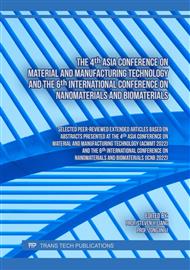[1]
A. Ressler, A. Žužić, I. Ivanišević, N. Kamboj, and H. Ivanković, "Ionic substituted hydroxyapatite for bone regeneration applications: A review," Open Ceram., vol. 6, p.100122, Jun. 2021.
DOI: 10.1016/j.oceram.2021.100122
Google Scholar
[2]
J. Anita Lett et al., "Recent advances in natural polymer-based hydroxyapatite scaffolds: Properties and applications," Eur. Polym. J., vol. 148, no. October 2020, p.110360, Apr. 2021.
DOI: 10.1016/j.eurpolymj.2021.110360
Google Scholar
[3]
M. R. Mohd Roslan et al., "The State of Starch/Hydroxyapatite Composite Scaffold in Bone Tissue Engineering with Consideration for Dielectric Measurement as an Alternative Characterization Technique," Materials (Basel)., vol. 14, no. 8, p.1960, Apr. 2021.
DOI: 10.3390/ma14081960
Google Scholar
[4]
S. Pai, M. S. Kini, and R. Selvaraj, "A review on adsorptive removal of dyes from wastewater by hydroxyapatite nanocomposites," Environ. Sci. Pollut. Res., vol. 28, no. 10, p.11835–11849, Mar. 2021.
DOI: 10.1007/s11356-019-07319-9
Google Scholar
[5]
R. Wati and Y. Yusuf, "Carbonated Hydroxyapatite Derived from Cerastoderma edule, Paphia undulata, and Meretrix meretrix Shells," IOP Conf. Ser. Mater. Sci. Eng., vol. 546, no. 4, p.042049, Jun. 2019.
DOI: 10.1088/1757-899X/546/4/042049
Google Scholar
[6]
A. S. Khan and A. A. Chaudhry, Handbook of Ionic Substituted Hydroxyapatites. Elsevier, 2020.
Google Scholar
[7]
F. Ren, X. Lu, and Y. Leng, "Ab initio simulation on the crystal structure and elastic properties of carbonated apatite," J. Mech. Behav. Biomed. Mater., vol. 26, p.59–67, Oct. 2013.
DOI: 10.1016/j.jmbbm.2013.05.030
Google Scholar
[8]
D. J. Patty, A. D. Nugraheni, I. D. Ana, and Y. Yusuf, "In vitro bioactivity of 3D microstructure hydroxyapatite/collagen based‐egg white as an antibacterial agent," J. Biomed. Mater. Res. Part B Appl. Biomater., p.1–13, Jan. 2022.
DOI: 10.1002/jbm.b.35009
Google Scholar
[9]
D. J. Patty, A. D. Nugraheni, I. D. Ana, and Y. Yusuf, "Dual functional carbonate-hydroxyapatite nanocomposite from Pinctada maxima and egg-white for bone tissue engineering," J. Biomater. Sci. Polym. Ed., vol. 33, no. 8, p.1043–1062, May 2022.
DOI: 10.1080/09205063.2022.2036934
Google Scholar
[10]
R. M. Anggraini and Y. Yusuf, "The Effect of Stirring Time on the Characteristics of Carbonated Hydroxyapatite from Pearl Shells (Pinctada maxima)," in IOP Conference Series: Materials Science and Engineering, 2019, vol. 546, no. 4.
DOI: 10.1088/1757-899X/546/4/042002
Google Scholar
[11]
Y. Rizkayanti and Y. Yusuf, "Optimization of the temperature synthesis of hydroxyapatite from indonesian crab shells," Int. J. Nanoelectron. Mater., vol. 12, no. 1, p.85–92, 2019, doi: 123456789/58781.
Google Scholar
[12]
I. Pawarangan and Y. Yusuf, "Characteristics of hydroxyapatite from buffalo bone waste synthesized by precipitation method," IOP Conf. Ser. Mater. Sci. Eng., vol. 432, p.012044, Nov. 2018.
DOI: 10.1088/1757-899X/432/1/012044
Google Scholar
[13]
M. Kwaśniak-Kominek, M. Manecki, J. Matusik, and M. Lempart, "Carbonate substitution in lead hydroxyapatite Pb5(PO4)3OH," J. Mol. Struct., vol. 1147, p.594–602, 2017.
DOI: 10.1016/j.molstruc.2017.06.111
Google Scholar
[14]
I. K. Januariyasa and Y. Yusuf, "Porous carbonated hydroxyapatite-based scaffold using simple gas foaming method," J. Asian Ceram. Soc., vol. 8, no. 3, p.634–641, Jul. 2020.
DOI: 10.1080/21870764.2020.1770938
Google Scholar
[15]
R. M. Anggraini, A. I. Supii, G. B. Suparta, and Y. Yusuf, "The Effect of pH on the Characteristics of Carbonate Hydroxyapatite Based on Pearl Shell (Pinctada maxima)," Key Eng. Mater., vol. 818, p.44–49, Aug. 2019.
DOI: 10.4028/www.scientific.net/KEM.818.44
Google Scholar
[16]
A. Ressler, A. Žužić, I. Ivanišević, N. Kamboj, and H. Ivanković, "Ionic substituted hydroxyapatite for bone regeneration applications: A review," Open Ceram., vol. 6, no. March, 2021.
DOI: 10.1016/j.oceram.2021.100122
Google Scholar



